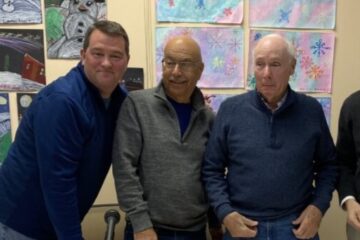
Steve Jasiecki/Fred Akers digs a hole for the platform post while Bill Stuempfig prepares ropes to pull the platform into position.
By STEVE JASIECKI
On a very cold but sunny February morning, Fred Akers, administrator of the Great Egg Harbor Rivershed Association, Bill Stuempfig, an osprey bander for the Conserv Wildlife Foundation, and I, set off to repair a badly leaning osprey platform. The nest on Shooting Island in Pecks Bay needed to be straightened, cleaned out and reinforced before the nesting osprey pair return for their summer visit.
One of the first signs of spring is the return of the ospreys in mid-March. The birds will fly thousands of miles from their wintering grounds to again breed and raise their chicks. The male returns first to prepare the nest for its mate. He will forage for branches, sod, sticks, bark, marsh grasses and anything that can be carried back to the nest. Every year the ospreys add to the already existing material in the nest so over a period of several years, the nest will become quite large and heavy.
The Division of Fish and Wildlife monitor the osprey nests. They count the chicks that hatch every year and take note of the condition of each nest. Any problems, such as excess nesting material or structural deficiencies, will be noted and worked on in the winter after the birds have left.
In this case, the overloaded nest was sinking into the marsh and it needed to be re-positioned and secured. After removing several pounds of nesting material we straightened and braceded the structure.

Fred Akers and Bill Stuempfig make repairs on the platform after straightening the post.
The osprey population wasn’t always as populous as it is today. They were threatened with extinction back in the 1960s due to pesticides that weakened their eggs so the chicks weren’t able to hatch. Shoreline development and tree removal took away their natural nesting sites so man made platforms were installed in the wetlands.
Banning DDT and building the nesting structures allowed the osprey population to rebound. Once considered an endangered species, they are now classified as a threatened species. This was a great environmental success story.
There is another threat that the ospreys face that is avoidable. As mentioned before, ospreys make their nest from whatever material they can find. Unfortunately, this includes plastic bags, rope and other trash. In the nest we repaired we found rope, plastic netting material, a rag, plastic bags and a discarded fishing pole.

Trash found in the osprey nesting platform.
With some spring cleaning and some home repairs, this osprey nest is now ready for the returning couple’s summer visit to the Jersey Shore.
Important note about ospreys: Ospreys are under the protection of federal and state laws. Only licensed personnel for the purpose of research and protection are permitted to approach their nest.
Steve Jasiecki is chairman of Sustainable Margate


